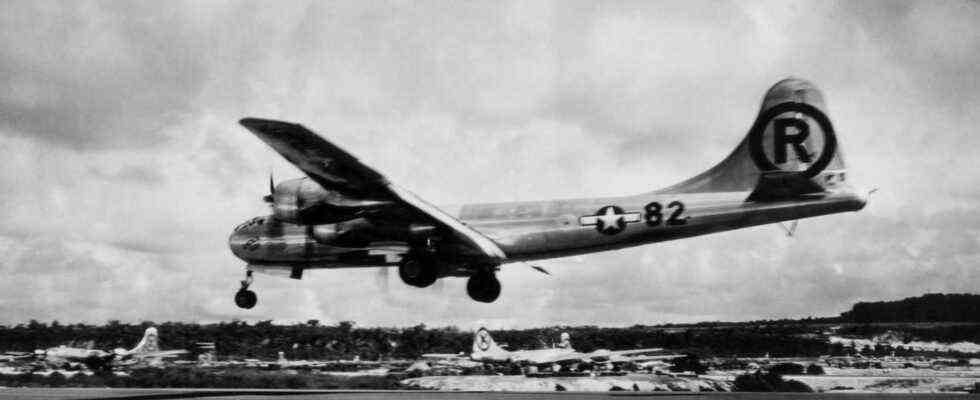Second World War
Superbomber B-29 – this machine brought the atomic bombs to Japan
B-29
© Picture Alliance
Actually, the super bomber B-29 was supposed to level Germany. They were only used in Asia. That type of bomber dropped the atomic bombs, ending World War II. But over Korea the B-29 wonder weapon was already hopelessly out of date.
In Germany, interest in the B-29 Superfortress was always less than that in the B-17. This is hardly surprising, because the B-29 was only used in Asia during the war. Only one bomber became famous, the “Enola Gay”. The plane from which the atomic bomb “Little Man” dropped on Hiroshima was named by the commander after his mother.
But the B-29 Superfortress was a technical miracle, it was the most advanced bomber of World War II. The silver, streamlined airplane was fundamentally different from all the others. The B-29 was designed with two requirements in mind: very long range and extreme altitude. The B-29 was designed as early as 1939 – as a weapon against Germany. The Americans feared that Hitler would occupy all of Europe and the British Isles. So they asked for an extreme range bomber.
Too high for defense
There was hardly any resistance to the B-29. The machine flew so high that it could not reach most of the fighter pilots and anti-aircraft guns. The crew could not have endured it only with breathing masks. The B-29 therefore had three pressurized cabins – an absolute novelty. The crew had to stay in them. Therefore, the four towers were remote-controlled with machine guns. Their engines had 18 cylinders and delivered 2200 hp. The B-29 dropped nine tons of bombs. The armed B-17 could only carry two tons of bombs on long-range missions.
The “Enola Gay” has been in the National Air and Space Museum in Chantilly since 2003. “The B-29 was a marvel of the modern age,” says Jeremy Kinney of the Smithsonian Institute. The restoration was worked on for 20 years. “It was the most advanced propeller-driven airplane that had ever been seen. But you have to combine that with the mission of the ‘Enola Gay’. Here we have a bomber with a bomb that is destroying a city.”
On September 21, 1942, the US B-29 Superfortress made its debut flight in Seattle. The program to build the bomber was carried out at full speed. In 1943, when the Allied bombers destroyed cities and industrial plants in Germany, the US bombers could not yet reach mainland Japan. Only the conquest of islands and the B-29 were to carry the war to the Japanese islands. Because of the time pressure, the first machines were assembled before all tests were completed. There were special centers for them so that they could later be brought up to date with the production version. In total, Boeing 2766 B-29 built. Bell Aircraft Co. assembled another 668 giant bombers and Glenn L. Martin Co. assembled another 536. Production ended in 1946.
B-29 over Japan
The first combat mission flew B-29 on June 5, 1944 over Bangkok in preparation for the Burma campaign. The bombers could not reach Japan until the US established airports on the Mariana Islands in the South Pacific. From there they destroyed Tokyo, in some cases a thousand machines took part in the attacks. B-29s were chosen for the atomic bombs because the Superfortress was the only machine that could carry a ten-ton bomb.
The rear gunner of the Enola Gay rear gunner, Staff Sgt. Robert Caron, watched the explosion over Hiroshima and later wrote, “I can still see it – that mushroom and that turbulent mass – it looked like lava or molasses that covered the whole city covered, and it seemed to flow outward into the foothills, where the little valleys came into the plain and all the fires kindled past, so soon it was difficult to see anything because of the smoke. ” Co-pilot, Capt. Robert Lewis reportedly stammered: “My God, what have we done?”
According to a conservative estimate, the men had no idea of the 100,000 victims. The planning was based on low losses. The Americans thought the Japanese would take refuge in the air raid shelters. In reality there was no alarm as only two US planes could be seen in the sky. The Japanese thought it was going to be a reconnaissance mission.
Not a machine for the jet age
The Korean War then showed how quickly a technical miracle can become obsolete. This is where B-29s flew most of the bombing missions. Until the Mig-15 appeared. The Mig-15 was a second generation jet fighter. It is considered to be the best fighter aircraft of the time and was initially flown by experienced Soviet pilots. In just five days between October 22 and 27, 1951, the Migs lifted eleven B-29s from the sky. And they increased. On a single day, October 30, the United States lost twelve B-29s and four F-84E escort fighters. With that the time of the Superfortress was over.


